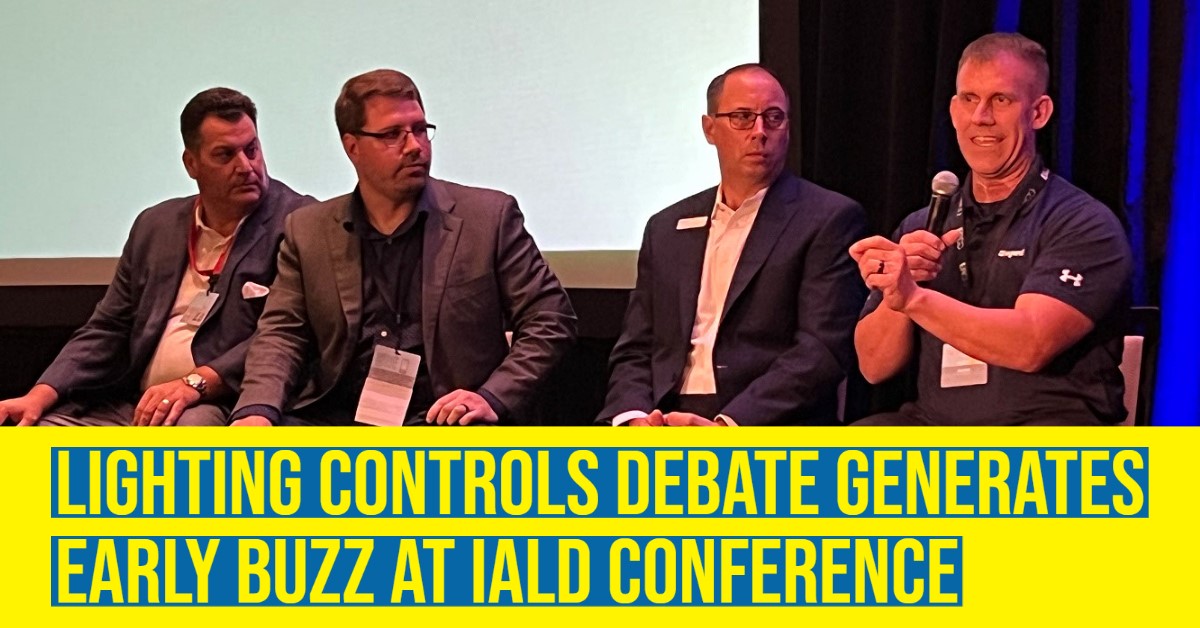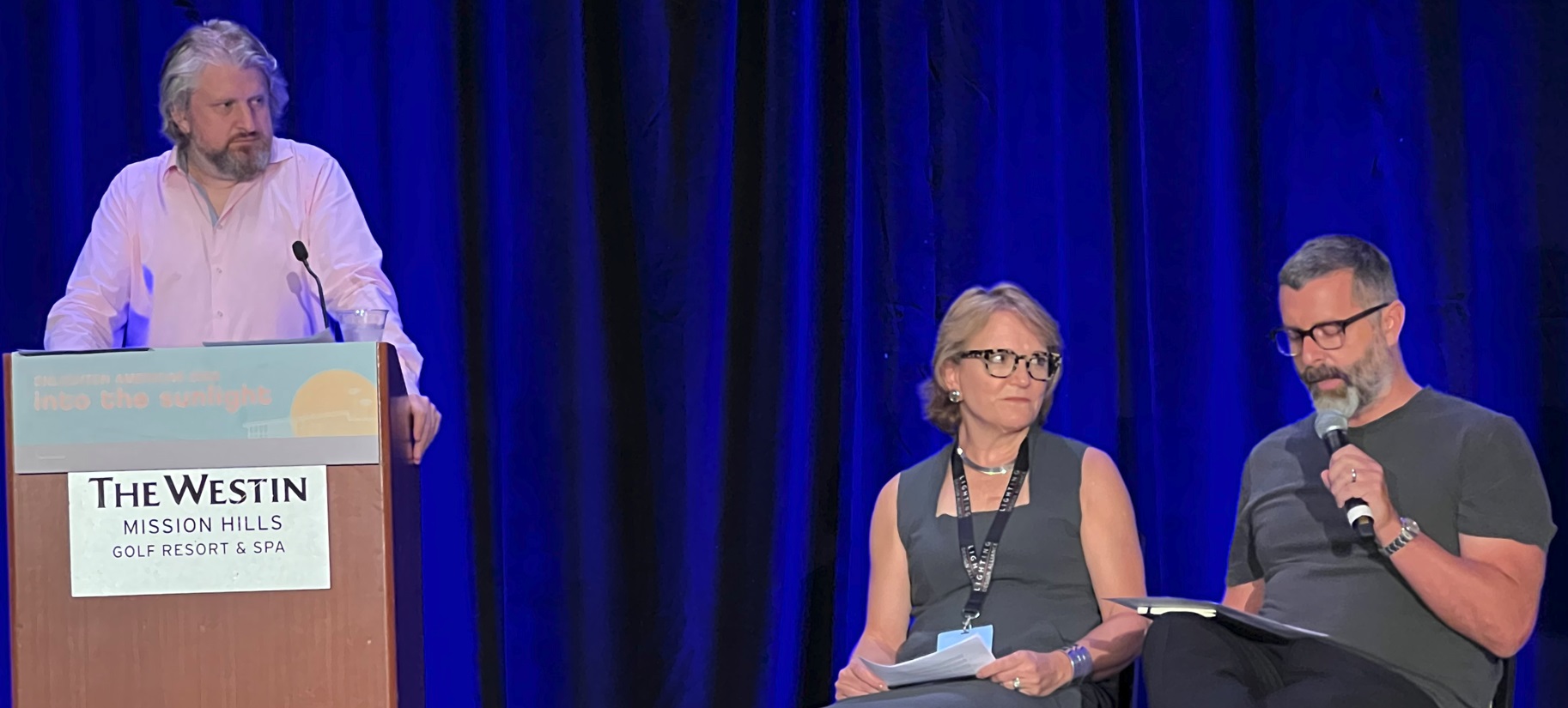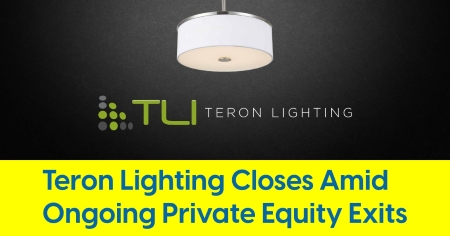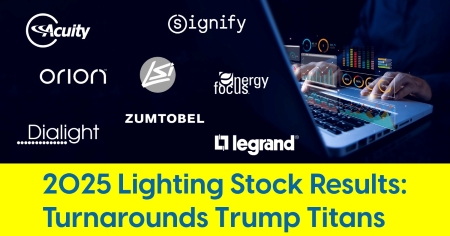September 30, 2022
Lighting Controls Debate Generates Early Buzz at IALD Conference
Above: Representatives from Lutron, Savant, Crestron and Vantage participate in forum
Hot-seat forum explored designers’ challenges with high end residential lighting controls systems
The 2022 IALD Enlighten Americas Conference kicked off Thursday in Palm Springs, California. The conference came in hot – and not just because outdoor temperatures were 99 °F. A certain lighting controls related program was generating anticipatory buzz causing lighting designers in attendance to wonder if conflict and tensions would be sparked on stage. Alas, the 2-hour program occurred in a measured, civil and professional manner with only a couple moments that landed as possibly petty and personal.
A late addition to the event schedule was the program entitled “Luxury Residential Lighting Control Forum” billed as “an opportunity for lighting designers to investigate multiple manufacturer options and to advocate for change in their product ranges and business models based on the needs of IALD lighting designers and their clients.”
Thomas Paterson of Lux Populi led the forum. He was joined by Sean O’ Connor of Sean O’Connor Lighting Design and Anne Kustner of AKLD Lighting Design. Four manufacturers participated and were each given 20-25 minutes to present their 5-minute opening remarks followed by a Q&A session with the panel and the audience.
The four residential lighting systems manufacturers that participated were:
-
Crestron
-
Legrand (Vantage)*
-
Lutron
-
Savant
*In a gangster move, Vantage requested to be listed as its parent company “Legrand” so it could be 2nd in the alphabetical lineup and manufacturer batting order – not last.
Above: Thomas Paterson, Anne Kustner and Sean O'Connor
Lutron faces & addresses scrutiny
Among the three designers, Paterson made the strongest statements about some of the challenges facing designers who are involved in large residential lighting controls projects. He called out Lutron by name for its 2021 business decision to make Lutron’s EcoSystem drivers available only in its own Ketra and Finiré products, and not available to other fixture manufacturers. Lutron’s business decision has been criticized by numerous lighting designers, including Paterson, as an unwanted limitation on residential system luminaire choice.
Paterson shared his disdain for being “confronted with CEDIA dealers who came to sell Ketra telling our clients that our lighting designs weren’t performing with any other dimming protocol because there would be a risk on the Lutron system. But gee, you just bought Ketra. It was tantamount to saying ‘This is a lovely house you have here, it would be a shame if it burned down.’”
Despite this IALD program occurring on the same day as the annual CEDIA Expo in Dallas, Texas, each manufacturer sent one or two representatives to participate on stage. The Lutron executives in attendance were Eric Lind, VP Global Specifications and Tom Ike, Executive Vice President.
Instead of providing a capabilities overview, Lutron used its opening comments to address the chatter and criticism, “We made a decision about 18 months ago, and when we look back on it, we made a mistake – and we'll be the first to tell you that." Later Lind explained that “Lutron has been supporting the lighting design community for 50+ years. I will say that it concerns me a bit that we made a decision that took away choice, and it's as if I shot somebody.”
Lind elaborated upon a recent Lutron announcement that should quell some of the concerns about restricting luminaire choices in Lutron residential systems. On September 16, Lutron announced broad support for DALI-2 in its HomeWorks residential lighting control systems as well as in its Athena commercial systems. Lutron touted that the addition of DALI-2 support is "offering lighting designers and engineers greater fixture compatibility, openness, and freedom to select the fixtures of their choice."
Lind went on to say that Ecosystem was developed in the late 90’s partly because, in Lutron’s assessment, DALI wasn’t yet ready for primetime and also because the lighting design community was asking them to develop a reliable, turnkey solution from one manufacturer that worked.
Other residential lighting controls issues share the spotlight
Paterson stated that controls represent the biggest risk for lighting designers when they specify residential lighting projects. Kustner repeatedly advocated for easy to find, capable local support for system design and programming. O’Connor explained scenarios in which homeowners’ TV or speaker selections often drive decisions about which dealer/installer is used on a project – which in turn cause a limited selection of lighting controls solutions offered by that same dealer.
Who gets the phone call when lights flicker?
The designers spent a lot of time exploring compatibility among controls, drivers and luminaires. They dug deep on understanding the credentials of licensed/certified dealers and installers. Is the integrator’s company certified or is it the individual doing the startup? Can we have a star system that rates installers? How can we discern between the different expertise levels and experience levels of various installers?
Given all of the focus on manufacturer compatibility and accountability, Lutron’s Ike made a strong statement that when Lutron provides the luminaires, drivers and controls, that Lutron owns the accountability of that project with no finger pointing. That prompted Paterson to call back and revise his earlier sound byte “This is a lovely house you have here, it would be a shame if your lights flicker.” Some attendees perceived this statement by Paterson to be more argumentative and less constructive. Earlier, as the Lutron executives were leaving the stage, Paterson made a sarcastic comment about Ike which was also perceived by some attendees as unnecessary, petty and personal.
Lutron’s unique capability of providing an entire system of luminaires, drivers and controls gives project stakeholders one throat to choke if things go awry – which seems like a compelling positive advantage for Lutron. The criticism comes, when they limited the specifiers' luminaire choice during the last 18 months – a situation that has been addressed with Lutron’s DALI-2 compatibilty.
Low-end dimming performance
There were numerous questions to the manufacturers about low end dimming performance and how it is measured. For instance, when a spec sheet reads that a fixture dims to 1%, how is it measured? Is it 1% of lumen output? Is it 1% of energy consumption? Is it an arbitrary value? There was no consensus methodology. Not all manufacturers had a clear technical answer top of mind.
There were also numerous questions about which part of the controls system bear responsibility for achieving the low-end published on the spec sheet. Lind explained, “The low-end dimming performance is usually going to be tied to the driver as the control system is simply sending a signal.” When Kustner followed up and asked “So you're saying it’s the driver manufacturer’s responsibility?” Lind replied, “I do.” Kustner then wondered “Do the driver manufacturers agree with that?”
Lighting Designer Pet Peeves:
DALI Statements from Manufacturers:
Kustner made a well-received point that the general term “DALI compatible” can have pitfalls if it isn’t describing the latest DALI-2 version. She urged all lighting controls stakeholders to specifically state “DALI-2” so misunderstandings don’t lead to something that only works on the older DALI protocol.
Upload times:
Manufacturers were being pressed for making onsite system configurations more user friendly. The designers explained they visit the homes in the evening to aim fixtures and configure controls systems. Upload times of 20-30 minutes or more seem to be a frustrating and time wasting part of the process for the designers and they pushed manufacturers to do significantly better. Vantage claimed that one of their largest, most complex projects uploaded in less than four minutes.
Moving forward:
The program seemed to give the panel, the forum and other stakeholders in attendance an opportunity to see lighting controls opportunities and pitfalls from multiple angles. With no dealers, integrators and installers in attendance, their perspectives were not shared, but overall the forum allowed for a healthy exchange of perspectives and information among designers and manufacturers.
It is clear that designers want a number of pretty fundamental things.
Designers want choice – the ability to select the optimal luminaires and controls for their projects without major restrictions.
Designers want transparency – minimal channel conflicts and reliable/thorough specification information from manufacturers.
Designers want clear accountability – designers don’t want to be caught in the middle of a finger-pointing blame game when hardware or software doesn’t work as it should.












